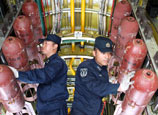
WUHAN, July 26 (Xinhua) -- A year away from the start of a major scheme to divert water from the water-abundant south of China to the arid north, a central Chinese city that is home to a major water source still faces huge challenges in pollution control.
A 370-square-km area in Danjiangkou in the city of Shiyan, Hubei Province, is scheduled to be inundated as of August to store water from the Hanjiang River, a major tributary of the Yangtze River, the country's largest.
The Danjiangkou reservoir, the water source of China's mega south-to-north water diversion project, is expected to supply water through canals and pipelines to the parched northern regions, including Beijing and Tianjin, starting mid 2014.
The inland poverty-stricken city, however, faces fund shortages in fighting pollution in five rivers that flow into the Danjiangkou reservoir as half of local sewage water is discharged untreated.
The water quality in one of the five rivers is labeled "grade IV," which means "industrial use only," and that in the other four is the worse "grade V," meaning "agricultural use only."
The water in all the five rivers needs to meet "grade III" by 2015, according to a water pollution control plan issued by the State Council, or China's cabinet.
"The target is very unlikely to be met as many pollution control projects lag behind schedule due to a fund shortage," said Cheng Jiagang, vice mayor of Shiyan.
The local government faces a fund gap of 3 billion yuan (486 million U.S. dollars) in building sewage pipes and ecological restoration facilities, and expanding sewage treatment capacity to clean up the rivers and meet the target, the official explained.

















 Working under 40 degrees Celsius
Working under 40 degrees Celsius


![]()
